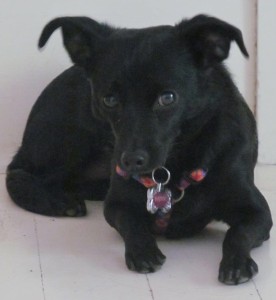
You and your dog—do you train alone?
Do you find yourself frustrated because so many training exercises require the help of another human and you don’t often have someone else around when you’re working with your dog?
There are some simple solutions to your training-alone issues.
First, a game you played in childhood is also great for training your dog: hide and seek. For your dog, the reward for “winning” this game is finding you and getting the treats or toys you have with you. The reward for you, the trainer, is teaching your dog to find you even when you’re out of sight.
Your dog will not understand the game initially, so make it easy. You want the dog’s successes to come early and often.

1. Wait until the dog is busy elsewhere. Sneak away, if you must. Your dog may not want to let you out of her sight! If you have a “velcro” dog, throw a treat or toy away from you and, when the dog runs to retrieve that reward, step around a corner or just out of the room.
2. Call the dog—once only, please. “Here!”
3. Then encourage the dog to find you by making a lot of noise. Be sure you make the kind of sounds that attract your particular dog. Clap, cheer, jump around, squeak a toy. Or, for a dog who’s shy of loud noise, try crinkling the wrapper of your dog treats.
4. The second the dog reaches you, take the dog’s collar in one hand and reward with the other. Verbal praise is also great: “Good Here!”
5. As the dog gets faster at responding to your call, as she begins to understand the game, reduce the encouragement and increase the rewards.
6. Stop the game on a success.

When the dog becomes accomplished at playing hide and seek inside, move the game to a safely fenced yard. No place to hide? How about under a blanket? Behind a tree? Inside the garage door? Expect the dog to be a bit slower outside than inside, at first. You will know the dog has learned how to play in both places when she’s just as fast outside as she is inside.
You want the dog to love the game and to be eager to play again. At any point in the training, if your dog does not respond, don’t get mad—figure out what’s wrong. Are you somehow discouraging the dog? Are the noises you’re making not attracting the dog? Is the dog afraid? Are your rewards not rewarding to the dog at that time?
Walk away, think about it, and later … try again. Remember, it’s your job to make it work, not the dog’s—you are the trainer!
NEXT WEEK: Training Alone – High & Low Tech Solutions



